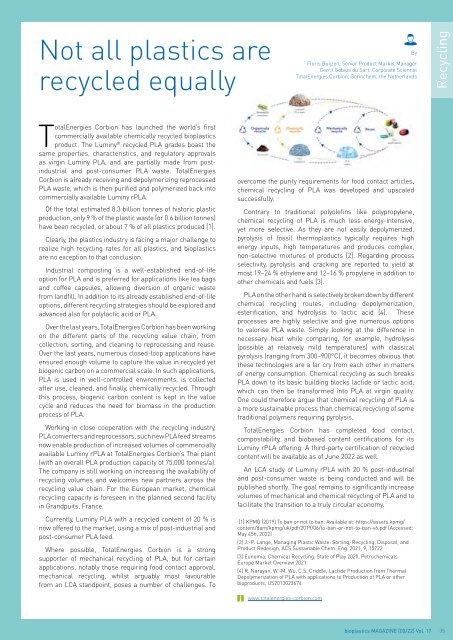Issue 03/2022
Highlights: Injection Moulding Beauty & Healthcare Basics: Biocompatibility of PHA Starch
Highlights:
Injection Moulding
Beauty & Healthcare
Basics:
Biocompatibility of PHA
Starch
Create successful ePaper yourself
Turn your PDF publications into a flip-book with our unique Google optimized e-Paper software.
Not all plastics are<br />
recycled equally<br />
Floris Buijzen, Senior Product Market Manager<br />
Gerrit Gobius du Sart, Corporate Scientist<br />
TotalEnergies Corbion, Gorinchem, the Netherlands<br />
By<br />
Recycling<br />
TotalEnergies Corbion has launched the world’s first<br />
commercially available chemically recycled bioplastics<br />
product. The Luminy ® recycled PLA grades boast the<br />
same properties, characteristics, and regulatory approvals<br />
as virgin Luminy PLA, and are partially made from postindustrial<br />
and post-consumer PLA waste. TotalEnergies<br />
Corbion is already receiving and depolymerizing reprocessed<br />
PLA waste, which is then purified and polymerized back into<br />
commercially available Luminy rPLA.<br />
Of the total estimated 8.3 billion tonnes of historic plastic<br />
production, only 9 % of the plastic waste (or 0.6 billion tonnes)<br />
have been recycled, or about 7 % of all plastics produced [1].<br />
Clearly, the plastics industry is facing a major challenge to<br />
realize high recycling rates for all plastics, and bioplastics<br />
are no exception to that conclusion.<br />
Industrial composting is a well-established end-of-life<br />
option for PLA and is preferred for applications like tea bags<br />
and coffee capsules, allowing diversion of organic waste<br />
from landfill. In addition to its already established end-of-life<br />
options, different recycling strategies should be explored and<br />
advanced also for polylactic acid or PLA.<br />
Over the last years, TotalEnergies Corbion has been working<br />
on the different parts of the recycling value chain, from<br />
collection, sorting, and cleaning to reprocessing and reuse.<br />
Over the last years, numerous closed-loop applications have<br />
ensured enough volume to capture the value in recycled yet<br />
biogenic carbon on a commercial scale. In such applications,<br />
PLA is used in well-controlled environments, is collected<br />
after use, cleaned, and finally, chemically recycled. Through<br />
this process, biogenic carbon content is kept in the value<br />
cycle and reduces the need for biomass in the production<br />
process of PLA.<br />
Working in close cooperation with the recycling industry,<br />
PLA converters and reprocessors, such new PLA feed streams<br />
now enable production of increased volumes of commercially<br />
available Luminy rPLA at TotalEnergies Corbion’s Thai plant<br />
(with an overall PLA production capacity of 75,000 tonnes/a).<br />
The company is still working on increasing the availability of<br />
recycling volumes and welcomes new partners across the<br />
recycling value chain. For the European market, chemical<br />
recycling capacity is foreseen in the planned second facility<br />
in Grandpuits, France.<br />
Currently, Luminy PLA with a recycled content of 20 % is<br />
now offered to the market, using a mix of post-industrial and<br />
post-consumer PLA feed.<br />
Where possible, TotalEnergies Corbion is a strong<br />
supporter of mechanical recycling of PLA, but for certain<br />
applications, notably those requiring food contact approval,<br />
mechanical recycling, whilst arguably most favourable<br />
from an LCA standpoint, poses a number of challenges. To<br />
overcome the purity requirements for food contact articles,<br />
chemical recycling of PLA was developed and upscaled<br />
successfully.<br />
Contrary to traditional polyolefins like polypropylene,<br />
chemical recycling of PLA is much less energy-intensive,<br />
yet more selective. As they are not easily depolymerized,<br />
pyrolysis of fossil thermoplastics typically requires high<br />
energy inputs, high temperatures and produces complex,<br />
non-selective mixtures of products [2]. Regarding process<br />
selectivity, pyrolysis and cracking are reported to yield at<br />
most 19–24 % ethylene and 12–16 % propylene in addition to<br />
other chemicals and fuels [3].<br />
PLA on the other hand is selectively broken down by different<br />
chemical recycling routes, including depolymerization,<br />
esterification, and hydrolysis to lactic acid [4]. These<br />
processes are highly selective and give numerous options<br />
to valorise PLA waste. Simply looking at the difference in<br />
necessary heat while comparing, for example, hydrolysis<br />
(possible at relatively mild temperatures) with classical<br />
pyrolysis (ranging from 300–900°C), it becomes obvious that<br />
these technologies are a far cry from each other in matters<br />
of energy consumption. Chemical recycling as such breaks<br />
PLA down to its basic building blocks lactide or lactic acid,<br />
which can then be transformed into PLA at virgin quality.<br />
One could therefore argue that chemical recycling of PLA is<br />
a more sustainable process than chemical recycling of some<br />
traditional polymers requiring pyrolysis.<br />
TotalEnergies Corbion has completed food contact,<br />
compostability, and biobased content certifications for its<br />
Luminy rPLA offering. A third-party certification of recycled<br />
content will be available as of June <strong>2022</strong> as well.<br />
An LCA study of Luminy rPLA with 20 % post-industrial<br />
and post-consumer waste is being conducted and will be<br />
published shortly. The goal remains to significantly increase<br />
volumes of mechanical and chemical recycling of PLA and to<br />
facilitate the transition to a truly circular economy.<br />
[1] KPMG (2019) To ban or not to ban. Available at: https://assets.kpmg/<br />
content/dam/kpmg/uk/pdf/2019/06/to-ban-or-not-to-ban-v6.pdf (Accessed:<br />
May 45h, <strong>2022</strong>)<br />
[2] J.-P. Lange, Managing Plastic Waste: Sorting, Recycling, Disposal, and<br />
Product Redesign, ACS Sustainable Chem. Eng. 2021, 9, 15722<br />
[3] Eunomia, Chemical Recycling: State of Play 2020, Petrochemicals<br />
Europe Market Overview 2021<br />
[4] R. Narayan, W.-M. Wu, C.S. Criddle, Lactide Production from Thermal<br />
Depolymerization of PLA with applications to Production of PLA or other<br />
bioproducts, US2013023674<br />
www.totalenergies-corbion.com<br />
bioplastics MAGAZINE [<strong>03</strong>/22] Vol. 17 35

















